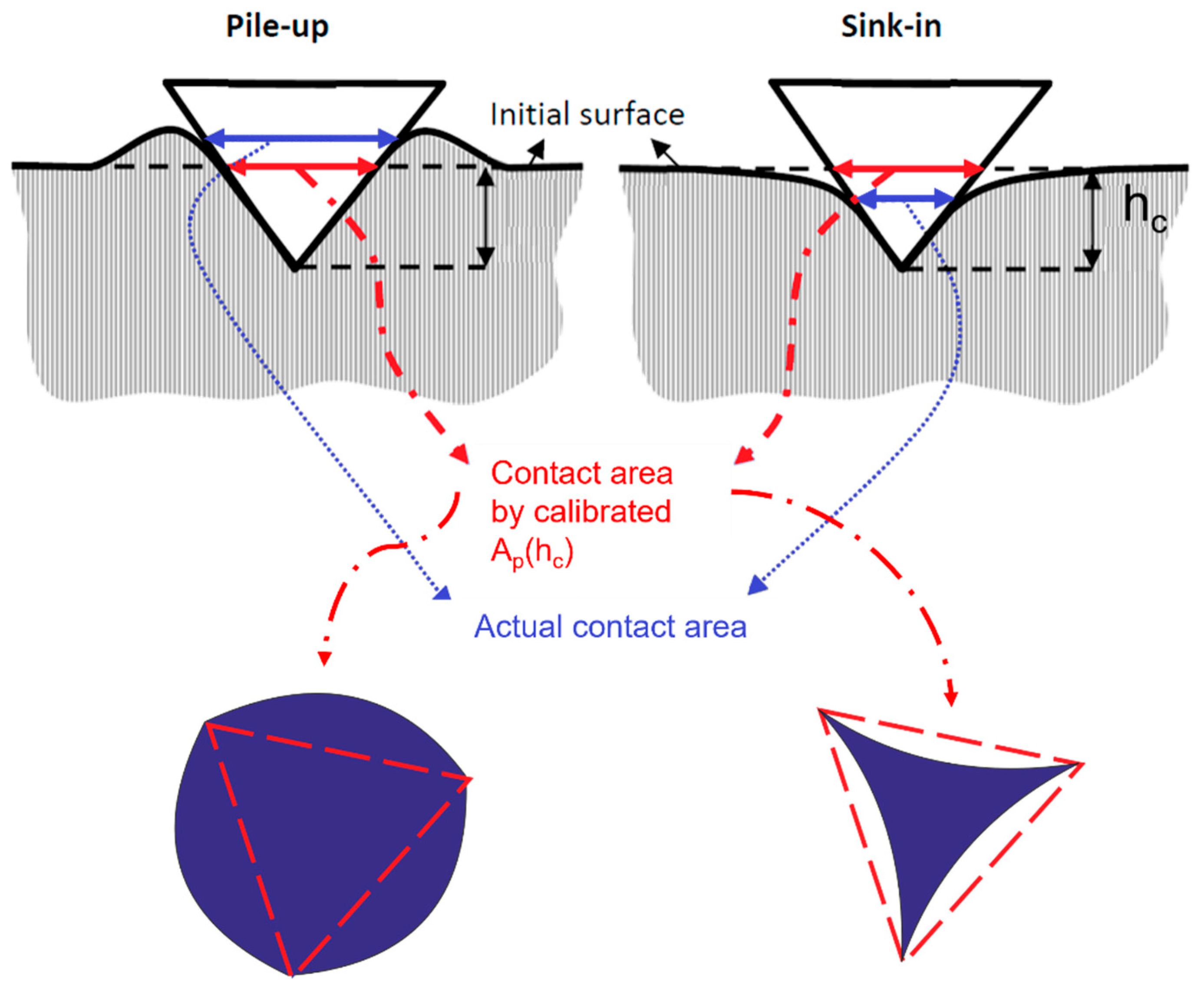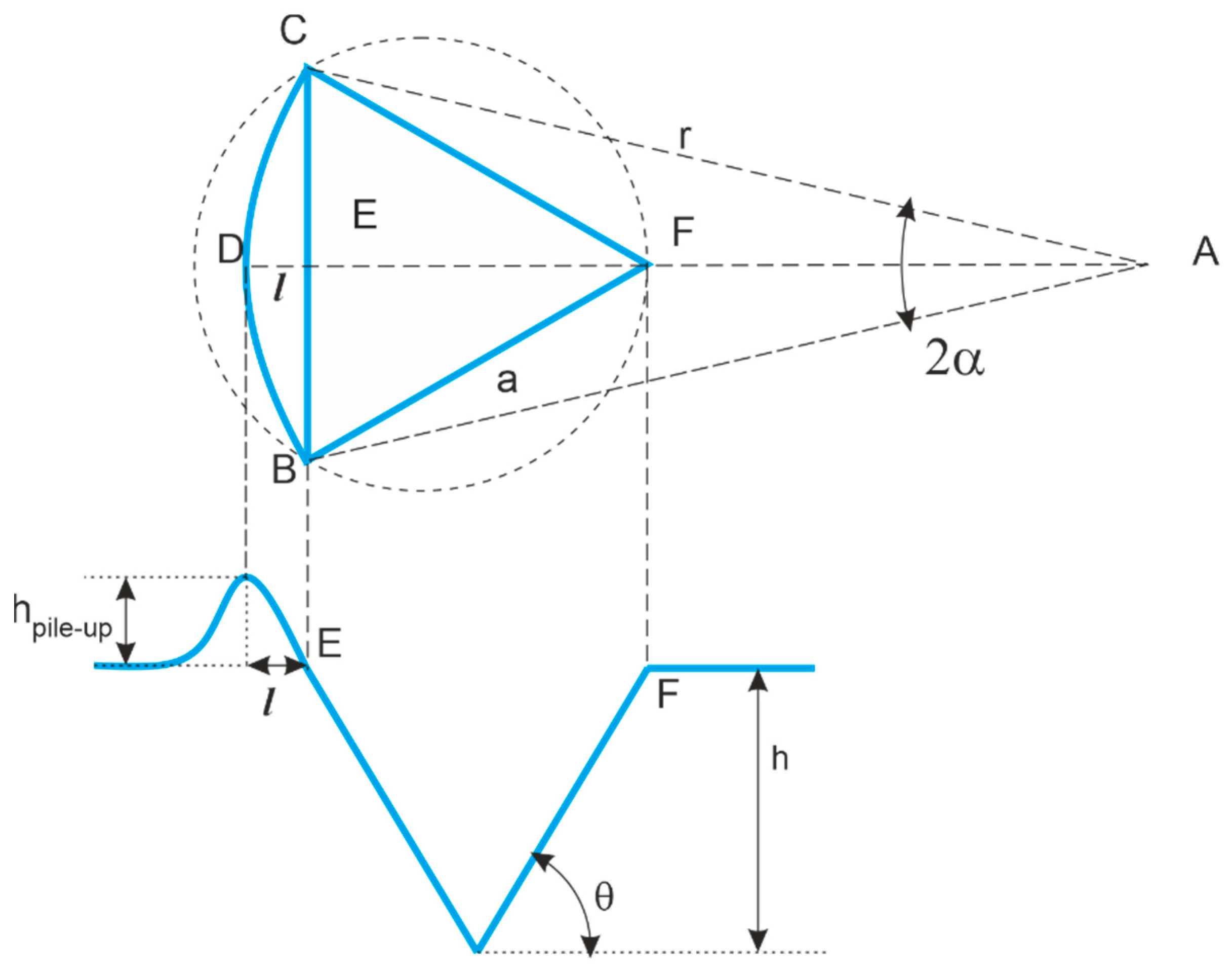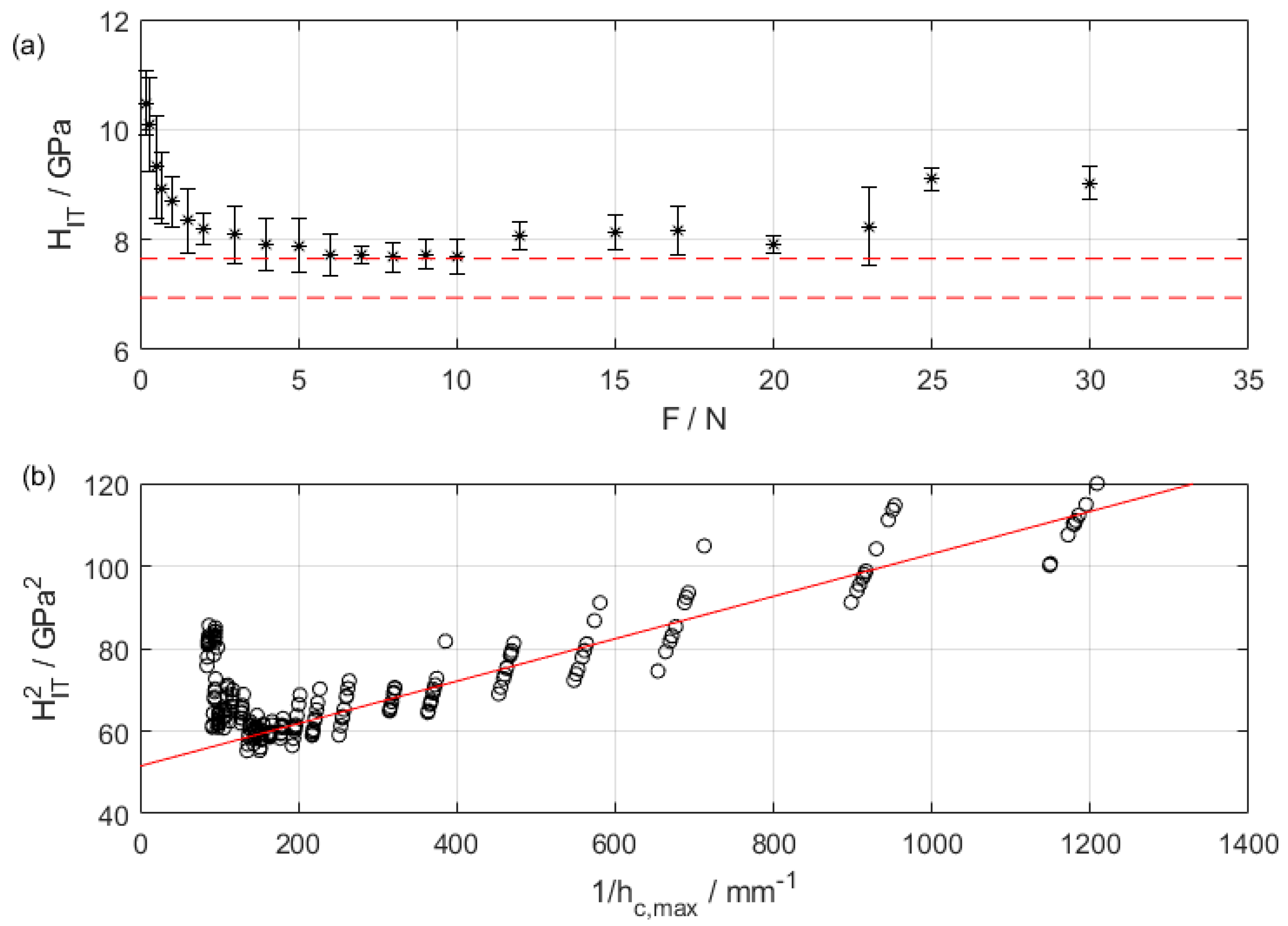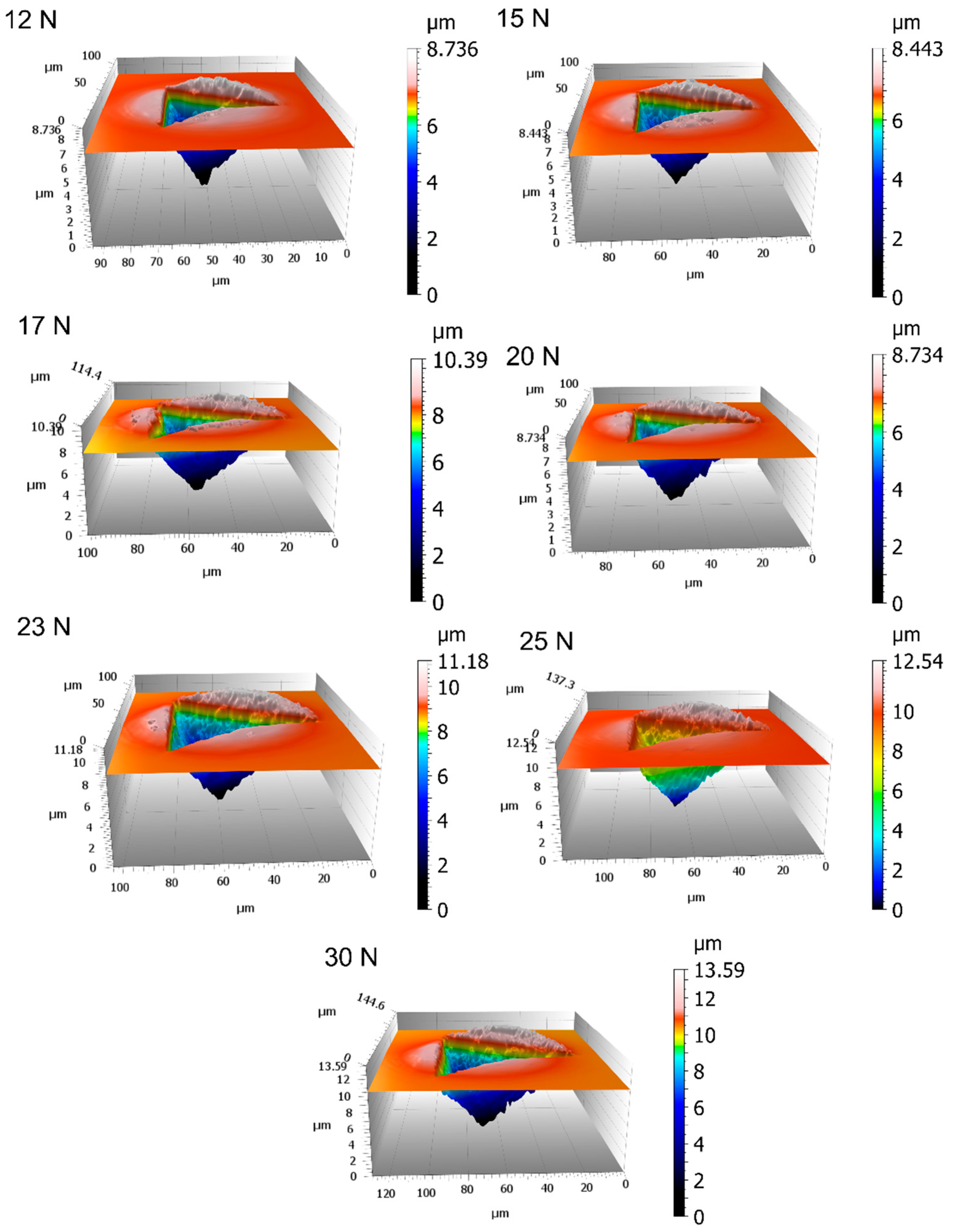Metrological Comparison of Available Methods to Correct Edge-Effect Local Plasticity in Instrumented Indentation Test
Abstract
1. Introduction
1.1. Edge-Effect Correction Methods
1.1.1. Oliver and Pharr (2004) (F/S2)
1.1.2. Qiu (2018) (Area)
1.1.3. Beegan et al. (2005) (W/V)
1.1.4. Indentation Size Effect (ISE)
1.1.5. Electrical Contact Resistance (ECR)
1.2. Scope of the Work
2. Materials and Methods
2.1. Experimental Set-up
2.2. Metrological Performance Evaluations
3. Results
4. Discussion
5. Conclusions
- different methods present significantly different metrological performances,
- Indentation Size Effect (ISE)-based modeling is more accurate (0.28 GPa with expanded uncertainty of 0.58 GPa),
- the data augmentation provided by the electrical contact resistance (ECR) shows the best precision (0.37 GPa) and second-best accuracy (0.33 GPa), and allows in-line correction, i.e., dispensing further post-processing,
- methods based on the analysis of the indentation curve (coupled with work-based modeling) and topographical measurements are suboptimal in terms of accuracy, leaving a systematic error after the correction.
Author Contributions
Funding
Institutional Review Board Statement
Informed Consent Statement
Data Availability Statement
Conflicts of Interest
References
- Lucca, D.; Herrmann, K.; Klopfstein, M. Nanoindentation: Measuring methods and applications. CIRP Ann.-Manuf. Technol. 2010, 59, 803–819. [Google Scholar] [CrossRef]
- ISO 14577-1:2015; Metallic Materials—Instrumented Indentation Test for Hardness and Material Parameters—Part 1: Test Method. ISO: Geneva, Switzerland, 2015.
- Yang, G.; Zhao, B.; Gao, Y.; Pan, F. Investigation of nanoindentation on Co/Mo multilayers by the continuous stiffness measurement technique. Surf. Coatings Technol. 2005, 191, 127–133. [Google Scholar] [CrossRef]
- Jian, S.-R.; Chen, G.-J.; Hsu, W.-M. Mechanical Properties of Cu2O Thin Films by Nanoindentation. Materials 2013, 6, 4505–4513. [Google Scholar] [CrossRef]
- Przystupa, K. Quality Evaluation of Selected Organic Coatings Used on Roofing Sheets. Materials 2022, 15, 1310. [Google Scholar] [CrossRef]
- Maculotti, G.; Genta, G.; Lorusso, M.; Galetto, M. Assessment of Heat Treatment Effect on AlSi10Mg by Selective Laser Melting through Indentation Testing. Key Eng. Mater. 2019, 813, 171–177. [Google Scholar] [CrossRef]
- Herbert, E.G.; Oliver, W.C.; Pharr, G.M. Nanoindentation and the dynamic characterization of viscoelastic solids. J. Phys. D Appl. Phys. 2008, 41, 074021. [Google Scholar] [CrossRef]
- Phani, P.S.; Oliver, W.C. Ultra High Strain Rate Nanoindentation Testing. Materials 2017, 10, 663. [Google Scholar] [CrossRef]
- Randall, N.X.; Vandamme, M.; Ulm, F.-J. Nanoindentation analysis as a two-dimensional tool for mapping the mechanical properties of complex surfaces. J. Mater. Res. 2009, 24, 679–690. [Google Scholar] [CrossRef]
- Engqvist, H.; Wiklund, U. Mapping of mechanical properties of WC–Co using nanoindentation. Tribol. Lett. 2000, 8, 147–152. [Google Scholar] [CrossRef]
- Maculotti, G.; Senin, N.; Oyelola, O.; Galetto, M.; Clare, A.; Leach, R. Multi-Sensor Data Fusion for the Characterisation of Laser Cladded Cermet Coatings. In Proceedings of the 19th International Conference and Exhibition, Bilbao, Spain, 3–7 June 2019; pp. 260–263. [Google Scholar]
- Hou, X.; Jennett, N.M.; Parlinska-Wojtan, M. Exploiting interactions between structure size and indentation size effects to determine the characteristic dimension of nano-structured materials by indentation. J. Phys. D Appl. Phys. 2013, 46, 265301. [Google Scholar] [CrossRef]
- Ohmura, T.; Wakeda, M. Pop-In Phenomenon as a Fundamental Plasticity Probed by Nanoindentation Technique. Materials 2021, 14, 1879. [Google Scholar] [CrossRef]
- Juliano, T.; Domnich, V.; Gogotsi, Y. Examining pressure-induced phase transformations in silicon by spherical indentation and Raman spectroscopy: A statistical study. J. Mater. Res. 2004, 19, 3099–3108. [Google Scholar] [CrossRef]
- George, J.; Mannepalli, S.; Mangalampalli, K.S.R.N. Understanding Nanoscale Plasticity by Quantitative In Situ Conductive Nanoindentation. Adv. Eng. Mater. 2021, 23, 2001494. [Google Scholar] [CrossRef]
- Figueroa, C.G.; Jacobo, V.H.; Cortés-Pérez, J.; Schouwenaars, R. Surface Nanostructuring of a CuAlBe Shape Memory Alloy Produces a 10.3 ± 0.6 GPa Nanohardness Martensite Microstructure. Materials 2020, 13, 5702. [Google Scholar] [CrossRef] [PubMed]
- Liang, T.; Yu, Q.; Yin, Z.; Chen, S.; Liu, Y.; Yang, Y.; Lou, H.; Shen, B.; Zeng, Z.; Zeng, Q. Spatial Resolution Limit for Nanoindentation Mapping on Metallic Glasses. Materials 2022, 15, 6319. [Google Scholar] [CrossRef] [PubMed]
- Gonabadi, H.; Oila, A.; Yadav, A.; Bull, S. Investigation of the Effects of Environmental Fatigue on the Mechanical Properties of GFRP Composite Constituents Using Nanoindentation. Exp. Mech. 2022, 62, 585–602. [Google Scholar] [CrossRef]
- Shetti, N.P.; Mehta, A.; Basu, S.; Mishra, A.; Malode, S.J.; Shukla, S.S.; Nadagouda, M.N.; Aminabhavi, T.M. Electrode materials for lithium-ion batteries. Mater. Sci. Technol. 2018, 1, 182–187. [Google Scholar] [CrossRef]
- Patel, M.; Karamalidis, A.K. Germanium: A review of its US demand, uses, resources, chemistry, and separation technologies. Sep. Purif. Technol. 2021, 275, 118981. [Google Scholar] [CrossRef]
- Zare, A.; Tunesi, M.; Harriman, T.A.; Troutman, J.R.; Davies, M.A.; Lucca, D.A. Face Turning of Single Crystal (111)Ge: Cutting Mechanics and Surface/Subsurface Characteristics. J. Manuf. Sci. Eng. 2023, 145, 071007. [Google Scholar] [CrossRef]
- Herrmann, K.; A Lucca, D.; Klopfstein, M.J.; Menelao, F. CIRP sponsored international comparison on nanoindentation. Metrologia 2010, 47, S50–S58. [Google Scholar] [CrossRef]
- Galetto, M.; Genta, G.; Maculotti, G. Single-step calibration method for nano indentation testing machines. CIRP Ann. 2020, 69, 429–432. [Google Scholar] [CrossRef]
- Kholkhujaev, J.; Maculotti, G.; Genta, G.; Galetto, M. Calibration of machine platform nonlinearity in Instrumented Indentation Test in the macro range. Precis. Eng. 2023, 81, 145–157. [Google Scholar] [CrossRef]
- Galetto, M.; Maculotti, G.; Genta, G.; Barbato, G.; Levi, R. Instrumented Indentation Test in the Nano-range: Performances Comparison of Testing Machines Calibration Methods. Nanomanufacturing Metrol. 2019, 2, 91–99. [Google Scholar] [CrossRef]
- Barbato, G.; Genta, G.; Cagliero, R.; Galetto, M.; Klopfstein, M.J.; Lucca, D.A.; Levi, R. Uncertainty evaluation of indentation modulus in the nano-range: Contact stiffness contribution. CIRP Ann.-Manuf. Technol. 2017, 66, 495–498. [Google Scholar] [CrossRef]
- Maculotti, G.; Genta, G.; Lorusso, M.; Pavese, M.; Ugues, D.; Galetto, M. Instrumented Indentation Test: Contact Stiffness Evaluation in the Nano-range. Nanomanufacturing Metrol. 2018, 2, 16–25. [Google Scholar] [CrossRef]
- Barbato, G.; Brondino, G.; Galetto, M.; Vicario, G. “Zero-Point” in the Evaluation of Martens Hardness Uncertainty. VDI BERICHTE 2002, 1685, 72–77. [Google Scholar]
- Germak, A.; Origlia, C. Investigations of new possibilities in the calibration of diamond hardness indenters geometry. Measurement 2011, 44, 351–358. [Google Scholar] [CrossRef]
- ISO 14577-2:2015; Metallic Materials-Instrumented Indentation Test for Hardness and Materials Parameters-Part 2: Verification and Calibration of Testing Machines. ISO: Genève, Switzerland, 2015.
- Maculotti, G.; Kholkhujaev, J.; Genta, G.; Galetto, M. Direct calibration of indenter tip geometry by optical surface topography measuring instruments. J. Mater. Res. 2023, 1–13. [Google Scholar] [CrossRef]
- Maculotti, G.; Genta, G.; Carbonatto, A.; Galetto, M. Uncertainty-Based Comparison of the Effect of the Area Shape Function on Material Characterisation in Nanoindentation Testing. In Proceedings of the 22nd International Conference and Exhibition of EUSPEN, Geneva, Switzerland, 30 May–3 June 2022. [Google Scholar]
- Nix, W.D.; Gao, H. Indentation size effects in crystalline materials: A law for strain gradient plasticity. J. Mech. Phys. Solids 1998, 46, 411–425. [Google Scholar] [CrossRef]
- Mattucci, M.; Cherubin, I.; Changizian, P.; Skippon, T.; Daymond, M. Indentation size effect, geometrically necessary dislocations and pile-up effects in hardness testing of irradiated nickel. Acta Mater. 2021, 207, 116702. [Google Scholar] [CrossRef]
- Cheng, Y.-T.; Cheng, C.-M. Effects of ‘sinking in’ and ‘piling up’ on estimating the contact area under load in indentation. Philos. Mag. Lett. 1998, 78, 115–120. [Google Scholar] [CrossRef]
- Veleva, L.; Hähner, P.; Dubinko, A.; Khvan, T.; Terentyev, D.; Ruiz-Moreno, A. Depth-Sensing Hardness Measurements to Probe Hardening Behaviour and Dynamic Strain Ageing Effects of Iron during Tensile Pre-Deformation. Nanomaterials 2020, 11, 71. [Google Scholar] [CrossRef] [PubMed]
- Ruiz-Moreno, A.; Hähner, P.; Kurpaska, L.; Jagielski, J.; Spätig, P.; Trebala, M.; Hannula, S.-P.; Merino, S.; de Diego, G.; Namburi, H.; et al. Round Robin into Best Practices for the Determination of Indentation Size Effects. Nanomaterials 2020, 10, 130. [Google Scholar] [CrossRef] [PubMed]
- Oila, A.; Bull, S. Nanoindentation testing of gear steels. Int. J. Mater. Res. 2003, 94, 793–797. [Google Scholar] [CrossRef]
- Trzepiecinski, T.; Lemu, H.G. A Three-Dimensional Elastic-Plastic Contact Analysis of Vickers Indenter on a Deep Drawing Quality Steel Sheet. Materials 2019, 12, 2153. [Google Scholar] [CrossRef]
- Montecinos, S.; Tognana, S.; Salgueiro, W. Influence of pile-up on nanoindentation measurements in Cu–2wt.%Be samples with precipitates. Trans. Nonferrous Met. Soc. China 2019, 29, 2340–2350. [Google Scholar] [CrossRef]
- Kværndrup, F.B.; Engelbrekt, C.; Kücükyildiz, C.; Somers, M.A.; Christiansen, T.L.; Winther, G. Area determination with pile-up and sink-in in nanoindentation of oxygen containing titanium. Mater. Today Commun. 2022, 30, 103218. [Google Scholar] [CrossRef]
- Filippov, P.; Koch, U. Nanoindentation of Aluminum Single Crystals: Experimental Study on Influencing Factors. Materials 2019, 12, 3688. [Google Scholar] [CrossRef]
- Tabor, D. The Hardness of Metals; Oxford University Press: London, UK, 1951. [Google Scholar]
- Chudoba, T.; Schwenk, D.; Reinstädt, P.; Griepentrog, M. High-Precision Calibration of Indenter Area Function and Instrument Compliance. JOM 2022, 74, 2179–2194. [Google Scholar] [CrossRef]
- A Stilwell, N.; Tabor, D. Elastic Recovery of Conical Indentations. Proc. Phys. Soc. 1961, 78, 169–179. [Google Scholar] [CrossRef]
- Beegan, D.; Chowdhury, S.; Laugier, M. Work of indentation methods for determining copper film hardness. Surf. Coatings Technol. 2005, 192, 57–63. [Google Scholar] [CrossRef]
- Chicot, D.; N’jock, M.Y.; Roudet, F.; Decoopman, X.; Staia, M.; Puchi-Cabrera, E.S. Some improvements for determining the hardness of homogeneous materials from the work-of-indentation. Int. J. Mech. Sci. 2016, 105, 279–290. [Google Scholar] [CrossRef]
- Maiti, P.; Bhattacharya, M.; Das, P.S.; Ghosh, J.; Mukhopadhyay, A.K. A critical note on nanoscale plasticity in 20 ZTA ceramics. Ceram. Int. 2019, 45, 25034–25043. [Google Scholar] [CrossRef]
- Pöhl, F.; Huth, S.; Theisen, W. Indentation of self-similar indenters: An FEM-assisted energy-based analysis. J. Mech. Phys. Solids 2014, 66, 32–41. [Google Scholar] [CrossRef]
- Sakai, M. Energy principle of the indentation-induced inelastic surface deformation and hardness of brittle materials. Acta Met. Mater. 1993, 41, 1751–1758. [Google Scholar] [CrossRef]
- Cheng, Y.-T.; Cheng, C.-M. Scaling approach to conical indentation in elastic-plastic solids with work hardening. J. Appl. Phys. 1998, 84, 1284–1291. [Google Scholar] [CrossRef]
- Cheng, Y.; Cheng, C. Can Stress-Strain Relationaship Be Obtained from Indentation Curves Using Conical and Pyramidal Indenters? J. Mater. Res. 1999, 14, 3493–3496. [Google Scholar] [CrossRef]
- Giannakopoulos, A.E.; Suresh, S. Determination of Elasto-Plastic Properties by Instrumented Sharp Indentation. Scr. Mater. 1999, 40, 1191–1198. [Google Scholar] [CrossRef]
- Cheng, Y.; Cheng, C. What Is Indentation Hardness? Surf. Coatings Technol. 2000, 133–134, 417–424. [Google Scholar] [CrossRef]
- Tuck, J.R.; Korsunsky, A.M.; Bull, S.J.; Davidson, R.I. On the application of the work-of-indentation approach to depth-sensing indentation experiments in coated systems. Surf. Coat. Technol. 2001, 137, 217–224. [Google Scholar] [CrossRef]
- Cheng, Y.-T.; Li, Z.; Cheng, C.-M. Scaling relationships for indentation measurements. Philos. Mag. A 2002, 82, 1821–1829. [Google Scholar] [CrossRef]
- Cheng, Y.-T.; Cheng, C.-M. Scaling, Dimensional Analysis, and Indentation Measurements. Mater. Sci. Eng. R Rep. 2004, 44, 91–149. [Google Scholar] [CrossRef]
- Zhou, X.; Jiang, Z.; Wang, H.; Yu, R. Investigation on methods for dealing with pile-up errors in evaluating the mechanical properties of thin metal films at sub-micron scale on hard substrates by nanoindentation technique. Mater. Sci. Eng. A 2008, 488, 318–332. [Google Scholar] [CrossRef]
- Dellis, S.; Xiao, X.; Terentyev, D.; Mergia, K.; Krimpalis, S.; Bakaev, A.; Messoloras, S. Mechanical properties of neutron-irradiated single crystal tungsten W(100) studied by indentation and FEM modelling. J. Nucl. Mater. 2021, 551, 152985. [Google Scholar] [CrossRef]
- Moharrami, N.; Bull, S. A comparison of nanoindentation pile-up in bulk materials and thin films. Thin Solid Films 2014, 572, 189–199. [Google Scholar] [CrossRef]
- Xia, Y.; Bigerelle, M.; Marteau, J.; Mazeran, P.-E.; Bouvier, S.; Iost, A. Effect of surface roughness in the determination of the mechanical properties of material using nanoindentation test. Scanning 2013, 36, 134–149. [Google Scholar] [CrossRef]
- Beegan, D.; Chowdhury, S.; Laugier, M.T. A nanoindentation study of copper films on oxidised silicon substrates. Surf. Coat. Technol. 2003, 176, 124–130. [Google Scholar] [CrossRef]
- Bobzin, K.; Brögelmann, T.; Brugnara, R.; Arghavani, M.; Yang, T.-S.; Chang, Y.-Y. Investigation on plastic behavior of HPPMS CrN, AlN and CrN/AlN-multilayer coatings using finite element simulation and nanoindentation. Surf. Coatings Technol. 2015, 284, 310–317. [Google Scholar] [CrossRef]
- Hu, J.; Zhang, Y.; Sun, W.; Zhang, T. Nanoindentation-Induced Pile-Up in the Residual Impression of Crystalline Cu with Different Grain Size. Crystals 2017, 8, 9. [Google Scholar] [CrossRef]
- Cabibbo, M. Instrumented Nanoindentation Tests Applied to Bulk Metallic Materials: From Calibration Issue to Pile-Up Phenomena. Materials 2021, 14, 6360. [Google Scholar] [CrossRef]
- Qiu, Y.; Bai, Q.; Fu, E.; Wang, P.; Du, J.; Chen, X.; Xue, J.; Wang, Y.; Wang, X. A novel approach to extracting hardness of copper/niobium (Cu/Nb) multilayer films by removing the substrate effect. Mater. Sci. Eng. A 2018, 724, 60–68. [Google Scholar] [CrossRef]
- Mallikarjunachar, G.; Ghosh, P. Pile-up response of polymer thin films to static and dynamic loading. Thin Solid Films 2019, 677, 1–12. [Google Scholar] [CrossRef]
- Saha, R.; Nix, W.D. Soft films on hard substrates—Nanoindentation of tungsten films on sapphire substrates. Mater. Sci. Eng. A 2001, 319–321, 898–901. [Google Scholar] [CrossRef]
- Oliver, W.C.; Pharr, G.M. Measurement of hardness and elastic modulus by instrumented indentation: Advances in understanding and refinements to methodology. J. Mater. Res. 2004, 19, 3–20. [Google Scholar] [CrossRef]
- Sullivan, M.; Prorok, B.C. Evaluating indent pile-up with metallic films on ceramic-like substrates. J. Mater. Res. 2015, 30, 2046–2054. [Google Scholar] [CrossRef]
- Park, M.S. Correction of the hardness measurement for pile-up materials with a nano indentation machine. J. Korea Acad. Coop. Soc. 2016, 17, 98–106. [Google Scholar] [CrossRef]
- Pharr, G.M.; Bolshakov, A. Understanding nanoindentation unloading curves. J. Mater. Res. 2002, 17, 2660–2671. [Google Scholar] [CrossRef]
- Antunes, J.; Fernandes, J.; Sakharova, N.; Oliveira, M.; Menezes, L. On the determination of the Young’s modulus of thin films using indentation tests. Int. J. Solids Struct. 2007, 44, 8313–8334. [Google Scholar] [CrossRef]
- Moy, C.K.; Bocciarelli, M.; Ringer, S.P.; Ranzi, G. Identification of the material properties of Al 2024 alloy by means of inverse analysis and indentation tests. Mater. Sci. Eng. A 2011, 529, 119–130. [Google Scholar] [CrossRef]
- Goto, K.; Watanabe, I.; Ohmura, T. Inverse estimation approach for elastoplastic properties using the load-displacement curve and pile-up topography of a single Berkovich indentation. Mater. Des. 2020, 194, 108925. [Google Scholar] [CrossRef]
- Nikas, G.K. Approximate analytical solution for the pile-up (lip) profile in normal, quasi-static, elastoplastic, spherical and conical indentation of ductile materials. Int. J. Solids Struct. 2021, 234–235, 111240. [Google Scholar] [CrossRef]
- Cao, Y.; Allameh, S.; Nankivil, D.; Sethiaraj, S.; Otiti, T.; Soboyejo, W. Nanoindentation measurements of the mechanical properties of polycrystalline Au and Ag thin films on silicon substrates: Effects of grain size and film thickness. Mater. Sci. Eng. A 2006, 427, 232–240. [Google Scholar] [CrossRef]
- Pharr, G.M.; Herbert, E.G.; Gao, Y. The Indentation Size Effect: A Critical Examination of Experimental Observations and Mechanistic Interpretations. Annu. Rev. Mater. Res. 2010, 40, 271–292. [Google Scholar] [CrossRef]
- Galetto, M.; Kholkhujaev, J.; Maculotti, G. Improvement of instrumented indentation test accuracy by data augmentation with electrical contact resistance. CIRP Ann.-Manuf. Technol. 2023, in press. [Google Scholar] [CrossRef]
- Genta, G.; Maculotti, G. Uncertainty evaluation of small wear measurements on complex technological surfaces by machine vision-aided topographical methods. CIRP Ann.-Manuf. Technol. 2021, 70, 451–454. [Google Scholar] [CrossRef]
- ISO 25178-2:2022; Geometrical Product Specifications (GPS)—Surface Texture: Areal. Part 2: Terms, Definitions and Surface Texture Parameters. ISO: Geneva, Switzerland, 2021.
- Maculotti, G.; Goti, E.; Genta, G.; Mazza, L.; Galetto, M. Uncertainty-based comparison of conventional and surface topography-based methods for wear volume evaluation in pin-on-disc tribological test. Tribol. Int. 2022, 165, 107260. [Google Scholar] [CrossRef]
- Pharr, G.M.; Oliver, W.C.; Cook, R.F.; Kirchner, P.D.; Kroll, M.C.; Dinger, T.R.; Clarke, D.R. Electrical resistance of metallic contacts on silicon and germanium during indentation. J. Mater. Res. 1992, 7, 961–972. [Google Scholar] [CrossRef]
- Leach, R.K.; Haitjema, H.; Su, R.; Thompson, A. Metrological characteristics for the calibration of surface topography measuring instruments: A review. Meas. Sci. Technol. 2020, 32, 032001. [Google Scholar] [CrossRef]
- JCGM100: Evaluation of Measurement Data—Guide to the Expression of Uncertainty in Measurement (GUM); JCGM: Sèvres, France, 2008. [CrossRef]
- Montgomery, D.; Runger, G.; Hubele, N. Engineering Statistics; John Wiley & Sons Inc.: New York, NY, USA, 2010. [Google Scholar]







| Edge-Effect Correction Method | Literature Sources | Notes |
|---|---|---|
| Work/Energy | [35,45,46,47,48,49,50,51,52,53,54,55,56,57] | From the fundamentals derived by Stilwell and Tabor [45], the seminal work of Sakai [50] was later modified and refined by Cheng and Cheng [57]. Effect of indenter geometry [53], materials and substrates for coating were more recently introduced [46,48]. |
| Topographical measurement | Area evaluation [41,58,59,60] | Based on numerical evaluation from the Abbot–Firestone curve of a segmented portion of the indentation and edge-effect zones. The volume-based method also integrates work-based approaches originating from the work of Stilwell and Tabor [45]. |
| Volume evaluation [61] | ||
| Pile-up geometry measurement based on projected dimensions [62,63,64,65] or height [58] | The seminal work of Beegan et al. [62] was later modified and refined. Measurements typically rely on SPM [58,59,60,62,65,66,67] or optical instruments [41,61,63,64]. In some cases [62,63,66,67], profile measurements are considered, and the hypothesis of homogeneous pile-up is investigated [64,66] | |
| Analysis of the Indentation Curve | [68,69,70,71] | Mostly relying on Cheng and Cheng’s work-based approach [57] and additionally exploiting the constant and area-independent ratio F/S2 |
| Numerical Methods (FEM) | [72,73,74,75,76] | Largely exploited to address the inverse indentation problem to gather insight on material microstructure and localized plasticity. |
| Indentation Size Effect (ISE) | [33,77,78] | Nix and Gao proposed a model to predict and correct the ISE, but it also allows estimating a reference macro-hardness suitable to correct the pile-up. |
| Electrical Contact Resistance (ECR) | [79] | Exploiting data augmentation by in situ contact resistance measurement. |
| Correction Method | Acc/GPa | /GPa | p-Value Accuracy Test | p-Value Heteroskedasticity Test |
|---|---|---|---|---|
| F/S2 | 2.84 | 0.730 | *** | ** |
| Area—1 edge | 0.44 | 0.227 | *** | 7% |
| Area—3 edges | 0.40 | 0.199 | ** | * (3%) |
| W/V | 0.39 | 0.433 | >99.99% | 57% |
| ISE | 0.28 | 0.288 | >99.99% | 30% |
| ECR | 0.33 | 0.188 | 18% | * (2%) |
Disclaimer/Publisher’s Note: The statements, opinions and data contained in all publications are solely those of the individual author(s) and contributor(s) and not of MDPI and/or the editor(s). MDPI and/or the editor(s) disclaim responsibility for any injury to people or property resulting from any ideas, methods, instructions or products referred to in the content. |
© 2023 by the authors. Licensee MDPI, Basel, Switzerland. This article is an open access article distributed under the terms and conditions of the Creative Commons Attribution (CC BY) license (https://creativecommons.org/licenses/by/4.0/).
Share and Cite
Kholkhujaev, J.; Maculotti, G.; Genta, G.; Galetto, M. Metrological Comparison of Available Methods to Correct Edge-Effect Local Plasticity in Instrumented Indentation Test. Materials 2023, 16, 4262. https://doi.org/10.3390/ma16124262
Kholkhujaev J, Maculotti G, Genta G, Galetto M. Metrological Comparison of Available Methods to Correct Edge-Effect Local Plasticity in Instrumented Indentation Test. Materials. 2023; 16(12):4262. https://doi.org/10.3390/ma16124262
Chicago/Turabian StyleKholkhujaev, Jasurkhuja, Giacomo Maculotti, Gianfranco Genta, and Maurizio Galetto. 2023. "Metrological Comparison of Available Methods to Correct Edge-Effect Local Plasticity in Instrumented Indentation Test" Materials 16, no. 12: 4262. https://doi.org/10.3390/ma16124262
APA StyleKholkhujaev, J., Maculotti, G., Genta, G., & Galetto, M. (2023). Metrological Comparison of Available Methods to Correct Edge-Effect Local Plasticity in Instrumented Indentation Test. Materials, 16(12), 4262. https://doi.org/10.3390/ma16124262






